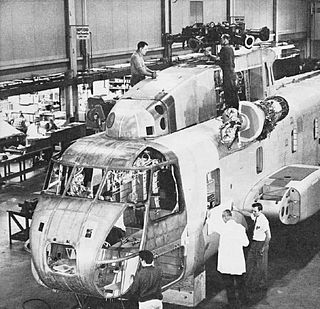D

This is a list of rotorcraft, including helicopters, autogyros, rotor kites and convertiplanes.
| Lists of aircraft |
|---|

(Jukka Tervamäki)
US Army helicopters designations:

An autogyro, or gyroplane, is a class of rotorcraft that uses an unpowered rotor in free autorotation to develop lift. Part 1 of Subchapter A of Chapter I of Title 14 of the U. S. Code of Federal Regulations states that gyroplane "means a rotorcraft whose rotors are not engine-driven, except for initial starting, but are made to rotate by action of the air when the rotorcraft is moving; and whose means of propulsion, consisting usually of conventional propellers, is independent of the rotor system." While similar to a helicopter rotor in appearance, the autogyro's unpowered rotor disc must have air flowing upward across it to make it rotate.
Westland Helicopters was a British aircraft manufacturer. Originally Westland Aircraft, the company focused on helicopters after the Second World War. It was amalgamated with several other British firms in 1960 and 1961.

The Piasecki X-49 "SpeedHawk" is an American four-bladed, twin-engined experimental high-speed compound helicopter developed by Piasecki Aircraft. The X-49A is based on the airframe of a Sikorsky YSH-60F Seahawk, but utilizes Piasecki's proprietary vectored thrust ducted propeller (VTDP) design and includes the addition of lifting wings. The concept of the experimental program was to apply the VTDP technology to a production military helicopter to determine any benefit gained through increases in performance or useful load.

The Kamov Ka-60 Kasatka is a Russian medium twin-turbine military transport helicopter under development by Kamov. It performed its first flight on 24 December 1998.

The Helicopter Museum in Weston-super-Mare, North Somerset, England, is a museum featuring a collection of more than 80 helicopters and autogyros from around the world, both civilian and military. It is based at the southeastern corner of the former Weston-super-Mare RAF Base.

The Panha 2091 "Toufan" is an Iranian overhaul and upgrade of the Bell AH-1J International attack helicopter purchased before the 1979 Islamic Revolution. The overhaul and upgrade program is known as project number 2091 of the Iranian Helicopter Support and Renewal Company.

The General Electric T700 and CT7 are a family of turboshaft and turboprop engines in the 1,500–3,000 shp (1,100–2,200 kW) class.

An aerial crane or flying crane is a helicopter used to lift heavy or awkward loads. As aerial cranes, helicopters carry loads connected to long cables or slings in order to place heavy equipment when other methods are not available or economically feasible, or when the job must be accomplished in remote or inaccessible areas, such as the tops of tall buildings or the top of a hill or mountain, far from the nearest road. Helicopters were first used as aerial cranes in the 1950s, but it was not until the 1960s that their popularity in construction and other industries began to catch on. The most consistent use of helicopters as aerial cranes is in the logging industry to lift large trees out of rugged terrain where vehicles are not able to reach, or where environmental concerns prohibit roadbuilding. These operations are referred to as longline because of the long, single sling line used to carry the load.

A transverse-rotor aircraft is an aircraft with two large horizontal rotor assemblies mounted side by side.

Classic Rotors is a flying aviation museum specializing in helicopters and other rotorcraft, located at Ramona Airport in Ramona, California, United States.

Helicopter manufacturers belong to the broader category of aerospace manufacturers. It is useful to think of helicopter manufacturers as falling into two categories, those that can design, certify and manufacture new helicopter designs from scratch and those that can only manufacture extant designs under license. Boeing Vertol is an example of the first type and Kawasaki Heavy Industries, who license-produced Boeing Vertol designs for much of its recent history, is an example of the second type.

Helicópteros del Sureste is a helicopter service based in Mutxamel, Alicante, Spain.

The Kamov Ka-92 is a high-speed coaxial compound helicopter design proposed by Kamov of Russia in competition with the Mil Moscow Helicopter Plant for a $1.3 billion project by the Russian government for development of a high-speed helicopter.

The Harbin Z-19 is a Chinese light reconnaissance/attack helicopter developed by Harbin Aircraft Manufacturing Corporation (HAMC) for the People's Liberation Army Air Force and the Ground Force Army Aviation. It is a specialized combat variant of the Harbin Z-9, which is a license-built version of the Eurocopter Dauphin.

The Hubschraubermuseum Bückeburg is located in the German town of Bückeburg, 30 miles (50 km) to the west of Hanover. The museum is the sole museum in Germany specialising in rotary-wing flight and one of few worldwide. The museum is dedicated to the history and technology of the helicopter.

The IAIO Toufan or Toophan is series of combat helicopters by the Iran Aviation Industries Organization. Based on the US-built AH-1J SeaCobra, the Toufan has two variants, the Toufan I unveiled in May 2010 and the improved Toufan II unveiled in January 2013.
![]() Media related to Rotorcraft at Wikimedia Commons
Media related to Rotorcraft at Wikimedia Commons